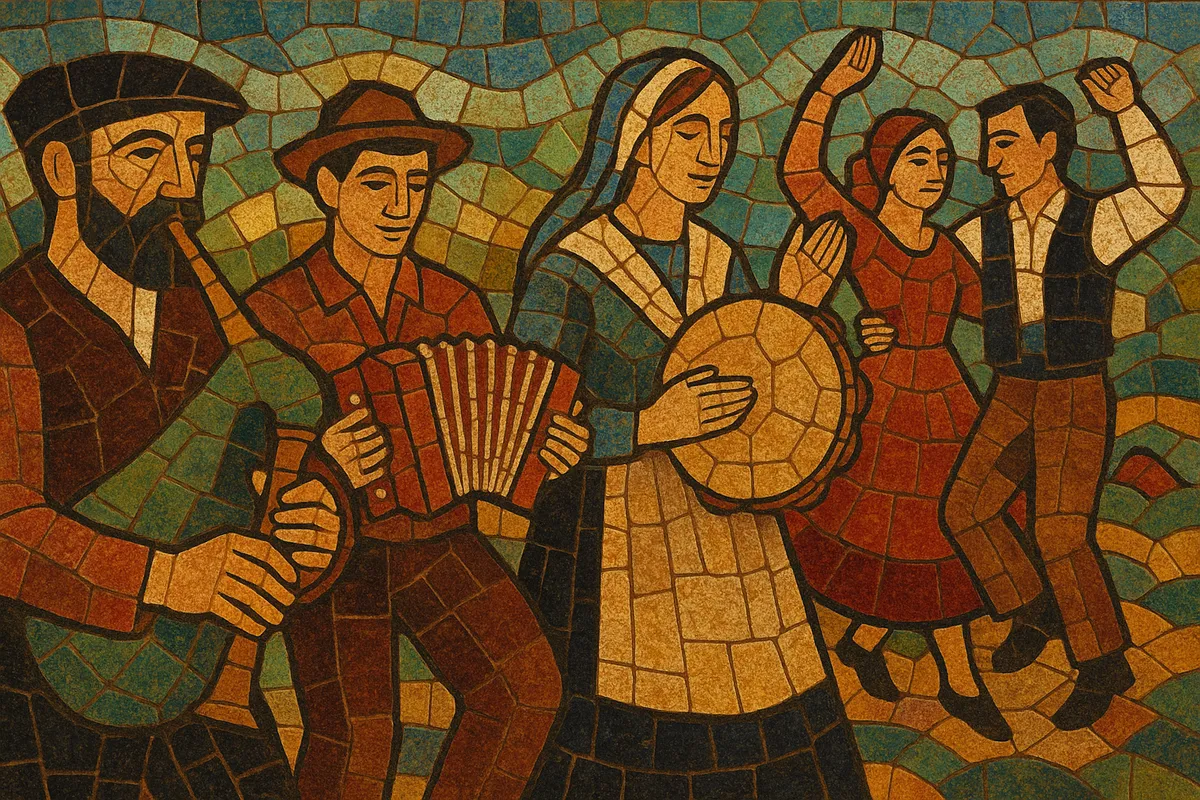Portuguese folk music is the umbrella term for Portugal’s regional traditional musics and dances, encompassing vocal and instrumental practices tied to social life, work, and ritual.
It includes lively circle and couple dances such as the Vira and Chula of Minho, the Corridinho of the Algarve, the Fandango of Ribatejo, the Bailinho of Madeira, and the Chamarrita of the Azores, alongside slower strophic songs (modas) and the powerful choral Cante Alentejano from the south.
Typical instruments include the gaita-de-fole (bagpipes), adufe (square frame drum), concertina and diatonic accordion, cavaquinho and regional violas (viola braguesa, toeira, amarantina), rabeca chuleira (fiddle), bombo (bass drum), and ferrinhos (triangle). Vocals often employ call-and-response, heterophony, and close parallel harmonies in Portuguese and, in some regions, Mirandese.
The style is communal and dance-oriented, performed at romarias (religious festivals), village gatherings, and seasonal celebrations. Melodies are diatonic and modal (often mixolydian or dorian), with simple harmonic supports when harmonized, and strong rhythmic patterns suited to participatory dancing.
Portuguese folk music has deep roots in rural life dating back to the medieval period, with dance- and work-songs evolving in villages, farms, and fishing communities. Distinct regions developed distinct vocabularies: Minho (Vira, Chula), Trás‑os‑Montes (Mirandese traditions and stick-dances), Ribatejo (Fandango), Beiras (adufe frame‑drum singing), Alentejo (polyphonic Cante Alentejano), Algarve (Corridinho), Madeira (Bailinho), and the Azores (Chamarrita).
In the 1800s, the rise of Romantic nationalism spurred interest in collecting rural song and dance. Ethnographers and local scholars began documenting melodies, instruments, and choreographies, helping to fix regional repertoires in print and subsequently in early recordings. This period laid the groundwork for a shared notion of “Portuguese folk music” beyond purely local practice.
During the mid‑20th century, state‑sponsored folklore groups (ranchos folclóricos) codified costumes, choreographies, and staged presentations, popularizing regional styles nationwide. From the 1960s onward, a folk revival emerged in parallel with música de intervenção (protest song), as artists and ensembles sought historically grounded yet contemporary performances of traditional material. Post‑1974 (after the Carnation Revolution), ensembles such as Brigada Victor Jara, Ronda dos Quatro Caminhos, and later Gaiteiros de Lisboa, Danças Ocultas, and others deepened research, instrumentation, and artistry.
In the 2000s, field research, archives, and festivals (e.g., Andanças; Intercéltico de Sendim) supported both preservation and new creation. UNESCO’s 2014 recognition of Cante Alentejano as Intangible Cultural Heritage highlighted the living power of regional traditions. Contemporary groups blend traditional instruments with modern arrangements, sustaining dance functions while expanding audiences at home and abroad.
Compose with dance in mind. Model grooves on traditional forms:
•Vira and Chula (Minho): lilting, driving triple or duple feels with strong upbeats; clear phrasing for circle/couple turns.
•Corridinho (Algarve) and Bailinho (Madeira): brisk duple meter with polka‑like bounce.
•Fandango (Ribatejo): percussive, showy rhythms suited to zapateado‑style footwork.
•Cante Alentejano: unaccompanied, slow to moderate tempos, broad phrases for choral blend.


